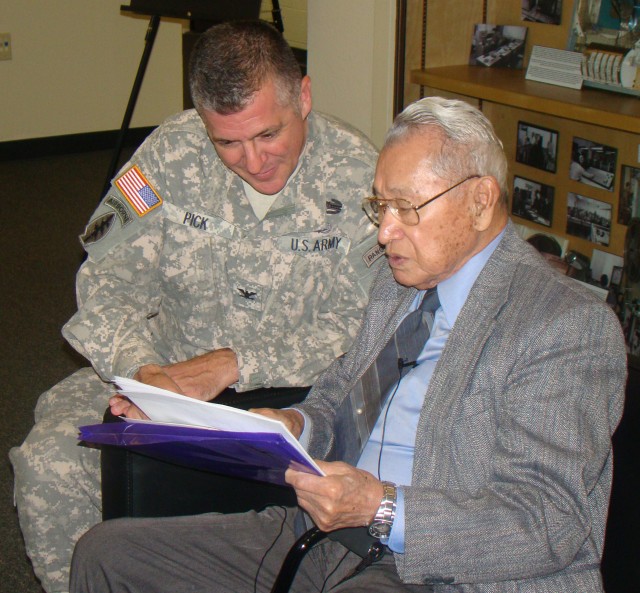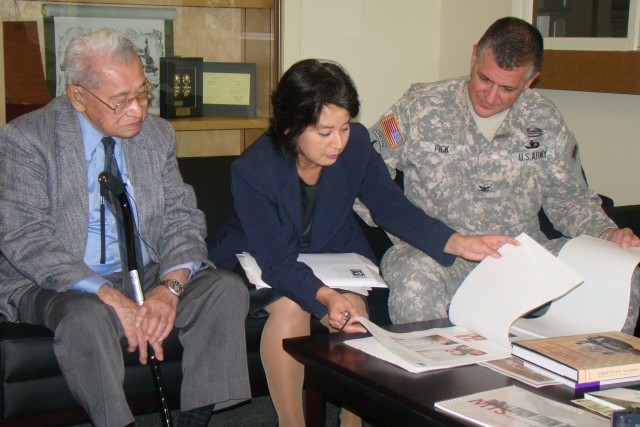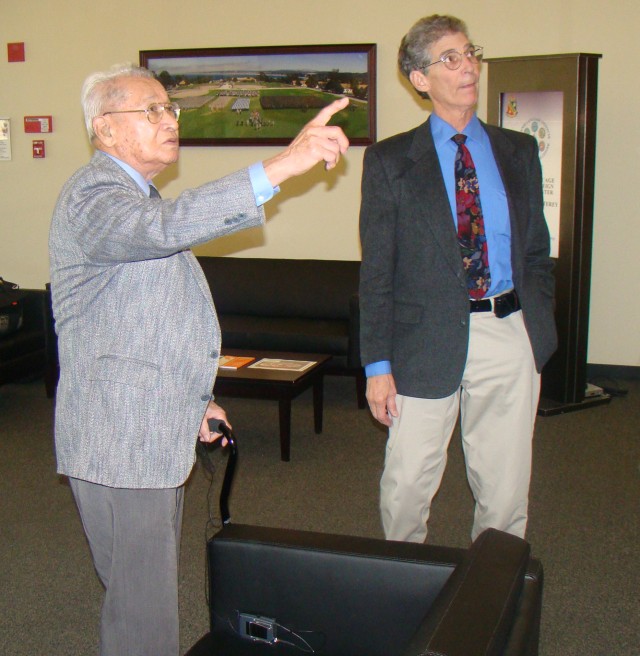PRESIDIO OF MONTEREY, Calif. - Defense Language Institute Foreign Language Center (DLIFLC) Commandant Col. Danial Pick was plainly delighted when greeting an afternoon visitor to the DLIFLC Headquarters Building on Oct. 27.
"I'm honored by your presence here today," Pick said. "I'm truly honored to meet you."
The visitor was U.S. Army Col. (Ret.) Thomas Sakamoto, who in the summer of 1941 had volunteered to become a member of the first class to be formed at the Fourth Army Language School (soon to be renamed the Military Intelligence Service Language school, or "MISLS") that was being organized in secrecy at the Presidio of San Francisco. It was a time of heightened diplomatic and economic tensions between the United States and Japan and the school's mission was to turn out linguists with Japanese language skills that would be useful in military operations if war broke out.
It was the first U.S. Army school to conduct foreign language training for military intelligence purposes and Army historians regard it as the predecessor of DLIFLC.
Sakamoto, now 92, is quick-witted with an easygoing sense of humor. He had made the trip to Monterey by car from the San Jose area where he resides. Longtime friends Fred Kitajima and Brian Shiroyama traveled with him and at the Presidio they were joined by Rosalyn Tonai, Executive Director of the San Francisco-based National Japanese American Historical Society.
The visit was a social call, but also an opportunity for the informal delegation to invite Pick to a Nov. 14 groundbreaking for a Japanese American Museum to be housed in the Presidio of San Francisco's Building 640, a former aircraft hangar facing Crissy Field, that was the original MISLS building.
A native of San Jose who was drafted into the Army in February 1941, Sakamoto remembers arriving at the 10,000-square-foot structure soon after it had been hastily fitted out with partitions to create classrooms and living quarters for some 60 volunteers, all but a few of them Japanese Americans. A few months earlier while serving as a buck private he had accepted an offer to join the school from an Army officer who was interviewing Nisei (second generation Japanese Americans born in the United States) soldiers stationed on the West Coast.
The interviewer was Capt. Kai Rasmussen, who would become the first MISLS commandant. The Headquarters Building at the Presidio of Monterey is officially named Rasmussen Hall in his honor, and by coincidence Sakamoto's meeting with Pick was arranged in the building's lobby within sight of a memorial plaque that bears Rasmussen's likeness.
Sakamoto not only completed the first MISLS course, he stayed on as an instructor after the school was relocated at Camp Savage, Minn. By then the United States and Japan were at war and Sakamoto volunteered for combat in the Pacific. At the end of the conflict Sakamoto was aboard the USS Missouri when Gen. Douglas MacArthur accepted Japan's surrender. Sakamoto was also among the first Americans in Japan at the outset of the U.S. occupation and was one of the first Americans to view the atom bomb destruction in Hiroshima.
In a 28-year career in military intelligence he completed DLIFLC's Russian Basic Course and Thai Basic Course. He was an instructor of Japanese in 1949-50 when the institute was known as the Army Language School.
The Japanese American Museum at Crissy Field has been discussed nationwide for several years and Sakamoto has been active in its planning and in fund-raising efforts.
Although much work remains before the museum is a reality, progress has been made and the Nov. 14 event promises to be an historic step.
"We visualize many people coming to the museum as tourists," Sakamoto told Pick. "Many thousands of tourists come to San Francisco every year. Access to the Presidio is going to be easier when some work on Doyle Drive is finished."
Planners envision a museum that will include a theater as well as exhibits related to the Japanese American experience.
Sakamoto expressed hope that the museum will honor the memory of Japanese Americans who fought for the United States in World War II, as well as those who suffered hardships in wartime internment camps.
But he said museum visitors will get more than military history.
"We don't want to remind them of war," Sakamoto said. "We want the museum to be a learning center."






Social Sharing